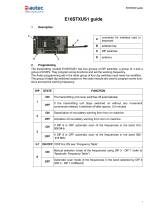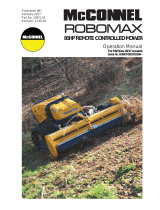
AUTEC
ENG
INDEX
Part A: Description, warnings and instructions
1 Dynamic Series description ............................................................................... A - 1
1.1 Technical data ................................................................................................. A - 1
1.2 Applications ..................................................................................................... A - 2
1.3 Radio link ........................................................................................................ A - 2
1.4 Classification of commands ............................................................................ A - 2
1.5 Safety functions .............................................................................................. A - 3
1.6 Identifying the radio remote control ................................................................. A - 4
2 Risk assessment ................................................................................................. A - 5
2.1 Risk assessment for radio remote controlled machines ................................. A - 5
2.2 Working conditions .......................................................................................... A - 6
3 Warnings .............................................................................................................. A - 7
3.1 Before starting to work .................................................................................... A - 7
3.2 During normal operation ................................................................................. A - 7
3.3 After using the radio remote control ................................................................ A - 8
4 Radio remote control lifecycle ........................................................................... A - 9
4.1 Transportation and storage ............................................................................. A - 9
4.2 Installation ....................................................................................................... A - 9
4.3 Use .................................................................................................................. A - 9
4.4 Radio remote control maintenance ............................................................... A - 10
4.5 Machine maintenance ................................................................................... A - 14
4.6 Disposal ........................................................................................................ A - 14
5 General operating instructions ........................................................................ A - 15
5.1 Starting up the radio remote control .............................................................. A - 15
5.2 Command activation ..................................................................................... A - 15
5.3 Data Feedback Function ............................................................................... A - 15
5.4 Radio link interruption ................................................................................... A - 16
5.5 Transmitting unit automatic switch off ........................................................... A - 16
5.6 Switching off the transmitting unit ................................................................. A - 17
5.7 Switching off the receiving unit ..................................................................... A - 17
6 Working .............................................................................................................. A - 18
6.1 BATTERY ..................................................................................................... A - 18
6.2 S-KEY ........................................................................................................... A - 18
6.3 START pushbutton ....................................................................................... A - 19
6.4 STOP ............................................................................................................ A - 19
6.5 Command meaning ....................................................................................... A - 19
6.6 Low Power function ....................................................................................... A - 21
6.7 Cable control ................................................................................................. A - 21
7 Troubleshooting ................................................................................................ A - 23
7.1 Radio remote controls with Data Feedback function .................................... A - 23
7.2 Radio remote controls with wire control ........................................................ A - 23




























